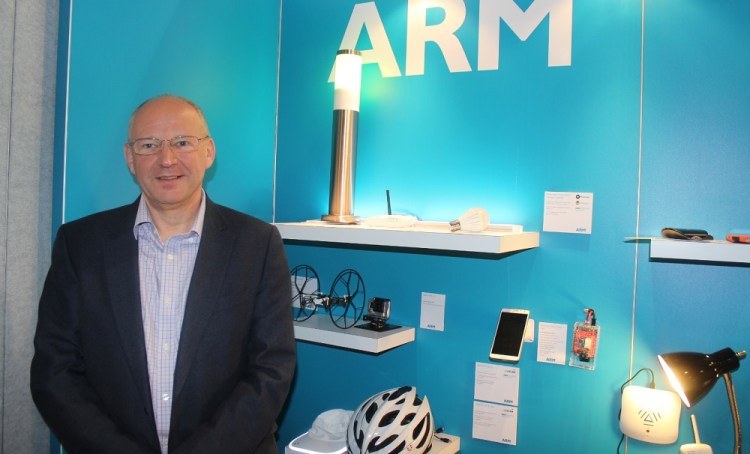VentureBeat: Yeah, I do.
Davies: I looked at phablets and said, “What is the point in that? It’s too big for a phone and too small for a tablet. That’s stupid.” Lo and behold, people went out and made them and have sold 100 or 200 million units last year. If I’d been predicting that, I’d never have done it. It taught me a valuable lesson, which is that what I think doesn’t always count. We should stick to what we’re good at, which is the component technologies that enable other people to have clever ideas.
VentureBeat: There’s that fine line between clever and crazy. Price has a lot to do with where that should be.
Davies: You have the reverse psychology thing. If you sell it for $18, people aren’t interested. If you sell it for $1,800, suddenly it’s incredibly attractive.
VentureBeat: What do you think are the emerging markets that you’re winning? In some ways Intel has finally stepped up. Everybody in the world has stepped into the Internet of Things. Is ARM still coming out on top?
Davies: So far the Internet of Things is absolutely running on ARM. Pretty much every single device you come across is based on ARM. No one else has made significant inroads yet. Can we keep up that market share? Well, it’s an open market, an open playing field. We have no right to a huge share. If they produce products that are useful and attractive, they’ll do well. But at the moment, wearables and the Internet of Things pretty much run entirely on ARM.
VentureBeat: What about your push into servers?
Davies: That’s a slow burn. We said last year that by the end of 2014 you would see ARM-based servers being shipped in commercial systems, and you do. They’re popular. HP is currently out of stock. You’ll have to go on a wait list. That must be selling well. I haven’t seen the numbers yet, but it’s doing well.
We see that as something that’s going to ramp up significantly. But it’s not like mobile and Fitbits. It’s not going to ramp up in three months. It’s going to ramp over some years. You’re talking about very conservative institutions buying these huge data centers. They have replacement policies. They’re retiring their kit over three- and four-year cycles.
The critical part there is not just the ARM low power, but the fact that we’re enabling diversification. Rather than saying, “The answer is this server or that server,” we say, “Here are our processors. Here’s our technology. Go build what you think you can make a successful product out of.” People are building networking servers. People are building transaction servers, web servers, base stations with server capability, a whole variety of product categories that previously weren’t possible. I think you’ll see that as one of the great advantages.
VentureBeat: What about the stories like Xiaomi in China — products that are designed just for China that also become giant. Are there a lot of examples of things like that?
Davies: We’re very well-placed in China. One of my colleagues on the senior management team of the graphics division is based in Shanghai. He’s been there for two and a half years. We have a significant engineering presence in Shanghai as well. We’ve been in the right place at the right time as companies like Xiaomi — we’ve got in at the start with these companies. They’ve been licensing quite a lot of technology from us because they have no particular legacy.
A greenfield account just says, “OK, I could build that, or I could buy that.” Oftentimes they say, “Yeah, I could build that. It’s a bit more expensive, because it’ll take me longer than just buying it,” but the time-to-market advantage is huge if you choose to license from us. Knowing that they can license it from us, that it’ll work, that the integration and the software will be easy — that’s something that has tended to be successful for us. If you look at the 70 licensees we have, a huge number of them are in Asia.
Xiaomi is an amazing company. The speed with which they work is terrifying. They’ll ring you on a Sunday night and they expect an answer before Monday.
VentureBeat: The infrastructure for the Internet of Things, is it already solid?
Davies: No, I think there’s a lot of change to happen there. Low-power Internet, low-power wireless, low-power communication protocols. There’s still a lot of work to be done. That’s one of the reasons why we bought a company called Sensinode, to help establish low-power Internet communications protocols. We saw that if you really do want something that’s going to be powered off a button cell, nailed to the wall, and left there for five years, you can’t do 802.11ac. It’s just not going to work.
VentureBeat: I saw some companies starting to do batteryless devices, trying to generate their own energy.
Davies: When you get the processes down to half a volt, things like that, that starts to become possible. It’s still hard.
VentureBeat: A lot of these things aren’t moving, too. You can’t harness motion energy.
Davies: The problem is, we all know you can have a self-winding clockwork wristwatch. There is energy to be harvested. But with that sort of smart watch there, it’s using quite a lot of power still. But it’s getting there.





